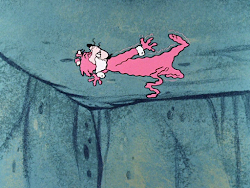Mark Kausler, the friend of all fans of old animation, acquired some story sketches for one of the Ruff and Reddy cartoons in Series ‘B’, Pinky the Pint-Sized Pachyderm and has been kind enough to send them so you can see them. He points out they’re from the pencil of none other than Joe Barbera himself. Barbera was an able and quick artist; Bill Hanna once marvelled about how fast Barbara was in creating sketches for the Tom and Jerry cartoons.
These are, perhaps, for a first draft of the story as they don’t quite reflect what ended up on the screen. Far from it, in a way. The board is labelled “B-9 Bungle in the Jungle.” While the title was kept, the drawings describe the storyline in the following episode, “Miles of Crocodiles.” And “Miles” was the 22nd, not the 9th, episode in the series. There may be a good explanation. If you’ve ever seen the Pinky serial, you may get the impression it’s two adventures mashed together. The first number of episodes involved Ruff, Reddy and Pinky on a pirate ship. Suddenly that plot ends and we find the three in a jungle being tracked by hunter Harry Safari. My wild guess is Barbera, Charlie Shows and maybe Dan Gordon came up with an adventure, found it was too short, so they tacked on the pirate cartoons at the start after establishing the story to stretch it out.
You’ll notice the board starts with drawing number 12. My next wild guess is the recap of the previous episode was in the preceding 11 panels (with, I presume, a different production number).
Charlie Shows’ finished dialogue and the scenario don’t match the first page of panels. Don Messick’s narrator begins with: “Ruff, Reddy and Pinky escape. But Harry Safari is hot on their trail again. Sheee.” And the scene cuts to Harry sniffing the ground. Forgive the murky version of this taken off a low resolution YouTube video taken off a cable TV feed. It’s a shame we will never see these on home video. While I’m not a fan of the series, I sure like the jungle background drawings in this adventure.



In some ways, the story stuck pretty close to Barbera’s drawings. Here are 16 and 17 from the cartoon. And Shows’ rhyming dialogue in panel 19 was kept intact.



Panels 20 and 21.





Notice in Panel 34 how Barbera indicates the silhouette of Reddy is to be animated to join up with the static drawing of Ruff and Pinky.



Panels 43 and 45. The “pan” instruction in Panel 44 is ignored. There’s a cut from one scene to the next. However, the camera pans over and then jerks upward a bit to get from 45 to 46. And Shows fits in another one of his rhyming couplets in lieu of the dialogue in Panel 47. “Relax, Max,” says Reddy.




Panel 53 has Pinky pointing with his finger. The cartoon did it better with Pinky pointing with his trunk (in a cycle of four drawings on twos).

In the actual cartoon, the dialogue in Panel 56 is “Fellas! It’s a Crod-ock-odile!” Daws Butler was noted for playing with words; I suspect that’s one of his contributions. Shows gives us more rhymes, as well as the name of the cartoon. The narration from Panel 57 to 59 goes “Not a cro-dock-odile, Reddy. But miles and miles of crocodiles. And each one with a large mouth full of teeth. Aren’t those choppers whoppers?” 56 in the actual cartoon has Reddy with close together cross-eyes. The panel has wide-apart eyes; Dan Gordon liked drawing characters that way, too.
The animation’s interesting. There are drawings of two crocodiles as per panels 57 and 58 on one cel while cycle animation of waves they make are overlaid. The waves fade out. The croc in the foreground suddenly opens his mouth wide (no in-between) and the drawing is held for 58 frames while the narration continues. There’s an eye close held for four frames, an eye open held for 16 frames and, well, it saves a pile of drawing.





There are no credits on any of the Ruff and Reddys except for the names of Bill Hanna and Joe Barbera. There’s so little animation besides walk cycles, mouth movements and eye blinks, I can’t tell you who was responsible (one scene ends without a mouth on Reddy). One scene has a shake take that Carlo Vinci liked using. The backgrounds may be the work of Fernando Montealegre; there are some flowers in some of the scenes and he drew them the same way in later H-B series.
It’s been speculated Harry Safari was lifted from Dishonest John from the Time For Beany puppet show. D.J. wasn’t an original character. Like Oil Can Harry in the Terrytoons cartoons, he was a caricature of an 19th century villain in stage melodramas. But the lineage of Harry’s “Nyah-ah-ah!” laugh points right to Dishonest John, and the fact that both Charlie Shows and Daws Butler worked on the Beany show make the connection far more than a mere coincidence.
Those of you who are new to the blog and are interested in this series can check out this post from 2009 and this post from 2013.



































